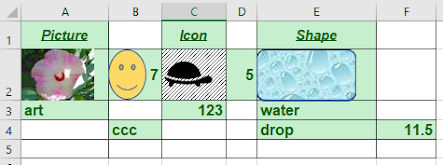You probably know how to hide some values in Excel cells. If not, this is how it can be done:
- select Home>Format in the Cells group, and then
- Format Cells...>Number>Custom, and then
- create the ; or ;; (single or double semicolon) and/or ;;; (triple semicolon) formats
With ; or ;; format you will be able to hide numeric values, and with ;;; format - all textual and numeric values.
The hiding of values can be enhanced with covering the cells with some graphics (pictures, icons or shapes) as you can see in this simple example:
Cells A2,C2 and E2 in this example are custom-formatted with ;;; so each of them may hold a hidden value. Cell A2 holds number 32.58, cell E2 holds value "TEXT" and cell C2 is left blank (no value). Cell B2 holds number 7 and is not custom-formatted. The range I've selected here is A1:F5. The graphics are used in this example just for masking; they are displayed in the top layer of the cells and may be used to hide even not custom-formatted cell value (like in cell B2).
Now, the question is, how you can determine if there are any hidden values within a selected range of cells. Even if you yourself created the spreadsheet some time ago, you may not remember if there are any hidden cell values and would like to check that.
You can use quite straightforward procedure to do that:
- select the range you want to check
- in the ribbon select Home>Conditional formatting (in Styles group) >Highlight Cells Rules>Text that Contains...
- under Format cells that contain the text: box enter * only and select highlighting option, e.g. Green Fill... , then click OK.
You'll see green-highlighted all cells that contain some values, including the hidden values.
If any of the cells are 'masked' with graphics, you may need to check them individually by temporarily resizing/moving them to see underlying content (if any). This way you'll know that all the green-highlighted cells contain values (doesn't matter if looking like blank or covered with graphics). Cells A2 and E2 have also been highlighted with green. It means there are hidden values entered there. Clicking on green areas show their content in the Formula Bar.Later on, you can remove the highlighting, if no longer needed. In the meantime, by using some formulas, you can make a number of different checks on the cells in the selected range to confirm existence of cells with hidden values. E.g.:
- =COUNT(A1:F5) Counts cells with numeric values in the selected range
- =COUNTA(A1:F5) or =COUNTIF(A1:F5,"<>") or =SUBTOTAL(103,A1:F5) Count cells with any value (not empty) in the selected range
- =SUM(A1:F5) Returns the sum of numeric values in the selected range
- =ISTEXT(E2) Returns TRUE if the cell contains text
- =COUNTIF(A1:F5,"") or =ROWS(A1:F5)*COLUMNS(A1:F5)-SUBTOTAL(103,A1:F5) Return count of blank cells in the selected range
- =IF(CELL("format",A2)="H","H","-") Returns "H" if the selected cell is custom-formatted to hide entered value
The last formula can be used to check for hidden values within the whole range/table of data.










